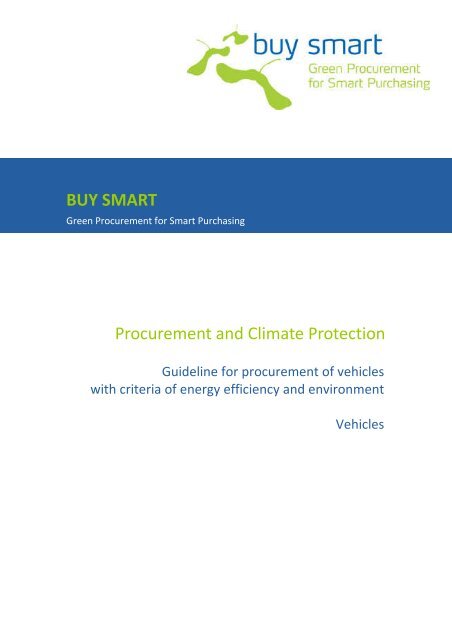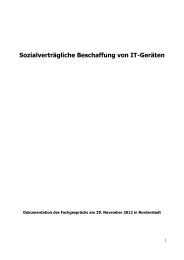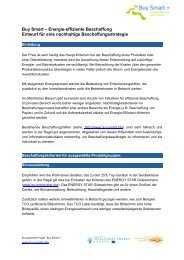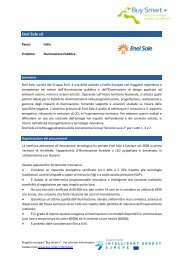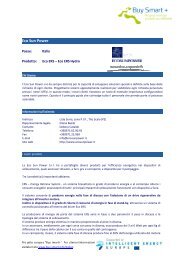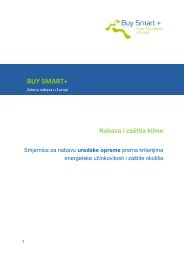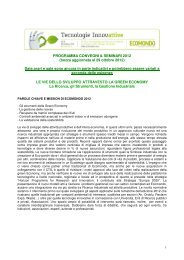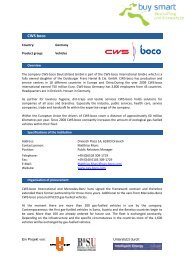Procurement and Climate Protection BUY SMART
Procurement and Climate Protection BUY SMART
Procurement and Climate Protection BUY SMART
Create successful ePaper yourself
Turn your PDF publications into a flip-book with our unique Google optimized e-Paper software.
<strong>BUY</strong> <strong>SMART</strong><br />
Green <strong>Procurement</strong> for Smart Purchasing<br />
<strong>Procurement</strong> <strong>and</strong> <strong>Climate</strong> <strong>Protection</strong><br />
Guideline for procurement of vehicles<br />
with criteria of energy efficiency <strong>and</strong> environment<br />
Vehicles
2<br />
Supported by<br />
www.buy-smart.info<br />
Guideline for green procurement of vehicles<br />
This guideline is provided within the framework of the European Union project “Buy smart –<br />
Green procurement for Smart Purchasing” funded by the program “Intelligent Energy – Europe”.<br />
Publisher: Berliner Energieagentur GmbH<br />
Französische Straße 23, 10117 Berlin<br />
E-Mail: office@berliner-e-agentur.de<br />
Internet: www.berliner-e-agentur.de<br />
Content development: Berliner Energiegentur GmbH:<br />
Kerstin Kallmann, Susanne Berger,<br />
Vanessa Hübner<br />
Öko-Insitut e. V., Berlin: Wiebke Zimmer<br />
Arrangement <strong>and</strong> text processing: Berliner Energieagentur GmbH<br />
Date: August 2009<br />
Disclaimer:<br />
The sole responsibility for the content of this guideline lies with the authors. It does not necessarily<br />
reflect the opinion of the European Communities. The European Commission is not responsible<br />
for any use that may be made of the information contained therein.
Guideline for green procurement of vehicles<br />
Content<br />
1. Introduction 4<br />
1.1 Dem<strong>and</strong>s on the "Clean Vehicle Fleet" 6<br />
2. Considered products <strong>and</strong> related criteria 8<br />
2.1 Products 8<br />
2.1.1 Available Propulsion Types <strong>and</strong> Fuel Alternatives 8<br />
2.1.2 Economical aspects 19<br />
2.1.3 Outlook towards Future Technologies 23<br />
3. Relevant European labels 25<br />
3.1 Labels 25<br />
4. Practical instructions for procurement <strong>and</strong> use of the group/product 27<br />
4.1 Environmentally Sound Vehicle Use in the "Clean Vehicle Fleet" 27<br />
4.1.1 Low Viscosity Oil (High lubricity Oil) 27<br />
4.1.2 Low Rolling Resistance Tires 27<br />
4.1.3 Tire Pressure 28<br />
4.1.4 Eco-Driving 28<br />
4.1.5 Use of Air Conditioning Systems <strong>and</strong> Independent Vehicle Heaters 28<br />
4.2 Practical procurement instructions 29<br />
4.2.1 Alternative A (calculation tool according to Guideline 2009/33/EG 29<br />
4.2.2 Alternative B (comprehensive procedure) 30<br />
5. References 31<br />
6. List of Abbreviations 31<br />
3
1. Introduction<br />
4<br />
Picture: AboutPixel.de<br />
Challenge N°. 1: <strong>Climate</strong> protection<br />
Guideline for green procurement of vehicles<br />
Transport is an indispensable component of our society<br />
<strong>and</strong> of our life. It constitutes an important pillar of our<br />
economic wealth. But it should not be ignored that the<br />
road traffic in particular contributes significantly to the<br />
emission of air pollutants <strong>and</strong> climate change gases. In<br />
spite of constant technical progress, the need for action<br />
for more environmental friendly products in the field of<br />
freight <strong>and</strong> passenger transport still remains.<br />
Since the 1990s, the beginning of the climate protection efforts around the Kyoto Protocol, the EU<br />
has registered an increase of more than 20 % in transport-related CO2 emissions. Successful re-<br />
ductions in other sectors are all but swallowed up by transport. About half of these transport-<br />
related CO2-emissions are caused by passenger cars, light utility vehicles, <strong>and</strong> buses. In Europe<br />
every year more than 15 million vehicles are newly registered, 92 % of them in the older EU-15.<br />
Improvements in the efficiency of vehicles, as achieved by the car industry in the past, have as yet<br />
been neutralised by a higher traffic volume <strong>and</strong> vehicles' (in some cases substantial) extra equip-<br />
ment <strong>and</strong> higher motorisation. It is of the utmost importance that the "climate-friendly" tech-<br />
nologies available on the market will be taken into consideration during vehicle procurement.<br />
Challenge N°. 2: Air Pollutants<br />
Furthermore, the transport - being the locally most significant cause of pollutant emissions (such<br />
as particulate matter) - has a central role to play in the prevention of air pollution. When evaluat-<br />
ing the pollutant emissions of vehicles, it has to be taken into consideration that they are emitted<br />
at face level – <strong>and</strong> therefore is not thinned. The traffic in cities causes up to 50 % of the particu-<br />
late matter emission, although it just reaches 20 % of the total particulate matter emissions. The<br />
need for action is also visible in the EU legal frameworks: in the past, the threshold value for par-<br />
ticulate matter, according to the European Air Quality Framework Directive 96/62/EC, has fre-<br />
quently been exceeded in many cities in Europe, so that the emissions load shall be reduced by<br />
further Clean Air Plans <strong>and</strong> Action Plans in the future. One important measure in the transport<br />
sector is therefore a traffic ban for vehicles with extremely high pollutant emissions in the city<br />
centres.
Guideline for green procurement of vehicles<br />
Challenge N°. 3: Noise<br />
Noise is another of the local problems in health <strong>and</strong> environmental protection. It is disturbing <strong>and</strong><br />
also poses a risk to health. The main cause for noise in cities is traffic: in Berlin, for example, 61 %<br />
of inhabitants at main roads have to deal with a noise level above 65 dB(A) at day-time; at night-<br />
time even more than 78 % are affected by noise levels of 55 dB(A). In research about the effects<br />
of noise, these values are already on the threshold of where noise can lead to health problems,<br />
which are hearing damages <strong>and</strong> stress leading to cardiovascular diseases.<br />
These numbers prove the necessity for traffic noise reduction. Besides measures in transport<br />
planning, such as speed limits at least at night-time, traffic ban for trucks, etc., noise emission<br />
reduction at the vehicle itself, e. g. by using low-noise <strong>and</strong> fuel-saving tyres, can contribute to<br />
environmental protection. Heavy utility vehicles definitely cause more noise; therefore they<br />
should be considered as a target for noise reduction.<br />
Accepting the challenge – Options for fleet operators<br />
In order to achieve the targets of the European Air<br />
Quality Framework, a wide range of technical <strong>and</strong><br />
user-related measures are necessary. Fortunately,<br />
clean propulsion technologies <strong>and</strong> fuels for vehicles<br />
in vehicle fleets already exist. Fleet operators will<br />
play an important role in the implementation of<br />
these technologies.<br />
Picture: AboutPixel.de<br />
With their choice, procurers of fleets can give the market a significant positive stimulus if they<br />
decide on the environmental friendly alternative, because their choice of vehicle also affects the<br />
used vehicle sector. Also financially, they often have an advantage over the private customer due<br />
to the lower specific costs by procuring large numbers of vehicles.<br />
On 23 rd April 2009 the European Community enacted the Directive 2009/33/EC on the promotion<br />
of clean <strong>and</strong> energy-efficient road vehicles, which commits purchasers of public authorities to<br />
consider environmental <strong>and</strong> efficiency criteria when purchasing vehicles. Apart from the energy<br />
consumption, CO2,emissions, nitrogen oxides, <strong>and</strong> particulate matter caused by the use of the<br />
vehicles during the entire life cycle have to be considered in the purchasing decision starting from<br />
04 th December 2010.<br />
5
The procurement of a "clean vehicle fleet" is a decision for:<br />
6<br />
� <strong>Protection</strong> of environment <strong>and</strong> climate<br />
� Less dependency on fuel prices<br />
Guideline for green procurement of vehicles<br />
� <strong>Protection</strong> against driving restrictions in city centre air pollution control areas<br />
� A possible step towards setting up an environment-friendly company image<br />
� Economic efficiency.<br />
However, it is evident that the uncertainty of vehicle fleet operators in particular with regard to<br />
the ecological advantages, the economic feasibility, <strong>and</strong> the future viability of "clean" procure-<br />
ment alternatives often prevents a more environmentally sound procurement.<br />
The intention of this guideline is to provide procurers with a product-neutral, manufacturer-<br />
neutral decision aid, which enables the environmental <strong>and</strong> economically sound selection of pro-<br />
pulsion technologies <strong>and</strong> fuels.<br />
The guideline includes:<br />
� Information on available technology for the "clean vehicle fleet"<br />
� Information on financial feasibility<br />
� General tips on procurement <strong>and</strong> vehicle operation<br />
� Introduction of environmental marks <strong>and</strong> labels as procurement tools<br />
� A proposed procedure for tenders for the "clean vehicle fleet"<br />
1.1 Dem<strong>and</strong>s on the "Clean Vehicle Fleet"<br />
The recommendations for the "clean vehicle fleet" consider the following aspects in procuring <strong>and</strong><br />
using vehicles:<br />
� <strong>Climate</strong> protection by lower greenhouse gas emissions<br />
� Low consumption of non-renewable resources<br />
� Prevention of local air pollutant emissions<br />
� Reduction of noise exposure<br />
� Contribution to the diversification of fuel supply.<br />
The guideline gives a higher priority to the principle of an economical procurement; its goal is to<br />
show – taking into consideration the total life cycle costs – that the economic <strong>and</strong> environmental<br />
choice of vehicles can coincide.
Guideline for green procurement of vehicles<br />
Following these preliminary remarks, the considerations <strong>and</strong> recommendations within this guide-<br />
line focus on efficient vehicles with conventional technology as well as on the propulsion alterna-<br />
tives <strong>and</strong> fuel alternatives, which can already be implemented in vehicle fleets today:<br />
� Efficient vehicles with Otto engines (gasoline engine) <strong>and</strong> diesel engines<br />
� Natural gas <strong>and</strong> liquid gas vehicles<br />
� Vehicles with hybrid propulsion<br />
� Biofuels (biodiesel, bio ethanol <strong>and</strong> biogas)<br />
Future technological alternatives, which cannot yet be economically implemented in vehicle<br />
fleets, are briefly presented as future perspectives.<br />
The addressed vehicle groups are: passenger cars, minibuses, vans, light utility vehicles, buses,<br />
<strong>and</strong> trucks – but without any details about specific requirements <strong>and</strong> vehicles for special purpose.<br />
In addition, equipment <strong>and</strong> materials for vehicles, such as tires, air conditioning systems, <strong>and</strong> mo-<br />
tor oils are taken into consideration as well as tips on economical driving.<br />
7
2. Considered products <strong>and</strong> related criteria<br />
2.1 Products<br />
2.1.1 Available Propulsion Types <strong>and</strong> Fuel Alternatives<br />
2.1.1.1 Conventional Vehicles<br />
8<br />
Guideline for green procurement of vehicles<br />
Conventional vehicles in this guideline are those using common fuels like petrol or diesel. Both<br />
kinds of propulsion are based on a combustion engine. Since the energy density of diesel fuel is<br />
higher than that of petrol <strong>and</strong> the efficiency factor of diesel engines is superior to the ones of<br />
gasoline engines, diesel vehicles consume less fuel than comparable gasoline vehicles. Thus CO2<br />
emissions are lower. However, when comparing current EURO4-passenger cars, it becomes clear<br />
that diesel vehicles still have higher particle <strong>and</strong> nitrogen oxide emissions than petrol vehicles,<br />
since the latter are equipped with regular catalytic converters. This problem is met by the intro-<br />
duction of particulate filters for diesel vehicles. After all, a significant disadvantage for diesel vehi-<br />
cles remains, in respect to nitrogen oxide emissions – they are higher than in petrol vehicles.<br />
Energy Consumption<br />
Transport accounts for 25.5 % of the energy<br />
consumption <strong>and</strong> 21 % of green house gas<br />
emissions in Europe – an increase of 23 % since<br />
1990. [EUROPEAN COMMISSION, 2006]<br />
Since CO2 emissions are directly related to<br />
vehicles fuel consumption, the energy dem<strong>and</strong><br />
of conventional vehicles constitutes an essential<br />
criterion for the road traffic effects on the<br />
climate. In principle, vehicles should be selected<br />
Picture: H. Huppertz<br />
by the lowest possible CO2 emissions within the car segment <strong>and</strong> configuration, i.e. the vehicles<br />
should be equipped to be as efficient as possible. Thereby the climate can be protected <strong>and</strong> the<br />
fuel expenses lowered. Depending on the annual kilometrage, fuel expenses can have a share of<br />
up to 50 % of the total life cycle costs of the vehicle.<br />
Consumption increases considerably with the size of the vehicle, but can vary greatly within a<br />
single vehicle model, as well. Thus, the CO2 emissions of a common medium-sized passenger car<br />
can vary by more than 50 % between the various versions of the model, due to differing perform-<br />
ance <strong>and</strong> components. Significant factors for the consumption of a vehicle are size, power <strong>and</strong><br />
equipment, like air conditioning, independent vehicle <strong>and</strong> seat heaters, which increase the con-<br />
sumption of fuel significantly.
Guideline for green procurement of vehicles<br />
Since 2005 information regarding fuel consumption <strong>and</strong> CO2 emissions of passenger cars are pro-<br />
vided in the showrooms.<br />
A report by the European Federation for Transport end Environment about CO2 emissions of dif-<br />
ferent br<strong>and</strong>s can be found here:<br />
http://www.transportenvironment.org/docs/Publications/2006/2006-<br />
10_how_clean_is_your_car_br<strong>and</strong>.pdf<br />
If passenger cars are classified accordingly to the segments of the German Kraftfahrtbundesamt<br />
(www.kba.de/EN/), the maximum CO2 emissions of the vehicle should be the must-criteria for<br />
each segment in the following table. About half the available automobiles reach these established<br />
criteria.<br />
However, in terms of climate protection these minimum requirements are not ambitious enough.<br />
According to EU directive 2009/33/EC, CO2 <strong>and</strong> other emissions are financially assessed <strong>and</strong><br />
added to the total automotive cost. In this way vehicles emitting a large amount of CO2 are be-<br />
coming more expensive.<br />
The classification of the vehicles is done by the manufacturers.<br />
CO2 emissions in g/km<br />
Must-criteria Vehicle with least CO2 emissions<br />
Mini 110 <strong>SMART</strong> FORTWO (88 g/km)<br />
Small cars 120 FORD FIESTE ECONECTIC (98 g/km)<br />
Compact cars 130 TOYOTA PRIUS (104 g/km)<br />
Middle class 150 VOLVO S40 1.6DDRIVE (118 g/km)<br />
Upper Middle class 170 BMW 520d (136 g/km)<br />
Upper class 270 BMW 6ER (183 g/km)<br />
SUVs 210 FORD KUGA (159 g/km)<br />
Vans 150 RENAULT MODUS (119 g/km)<br />
9
10<br />
Guideline for green procurement of vehicles<br />
Unfortunately there are no similar regulations for the publication of consumption values <strong>and</strong> CO2<br />
emission for transporters <strong>and</strong> small vans. Hence some of these vehicles are licensed as light utility<br />
vehicles. Some transporters below with a limited gross vehicle weight of 3.5 t are licensed as pas-<br />
senger cars. For those vehicles consumption <strong>and</strong> CO2 emissions are given in the vehicle descrip-<br />
tion. If no data is published, it should be available from the manufacturer. For transporters <strong>and</strong><br />
small vans the following CO2-criteria should be underlain for environmental-friendly vehicle pro-<br />
curement:<br />
CO2 emissions in g/km<br />
Must-criteria Vehicle with least CO2 emissions<br />
Transporters up to 3,5 t GVW 220 PEUGEOT BIPPER (119 g/km)<br />
A decline of CO2 emissions during the last years occurred for small cars. But lots of new products<br />
came along in the segments upper class, SUVs, <strong>and</strong> vans. The variety of models in these segments<br />
grew. And the average CO2 emissions in these segments increased as well.<br />
For transporters <strong>and</strong> vans the minimum m<strong>and</strong>atory criteria for an environment friendly procure-<br />
ment could be lowered compared to the criteria given in 2007.<br />
The Regulation (EC) No 443/2009 bounds car manufacturers to lower the average CO2 emission<br />
towards 95 g/km in 2020.<br />
Pollutant Emissions<br />
Urban air quality requirements have been considerably higher<br />
since 2005 due to the EU Air Quality Directive. Hence traffic is<br />
one of the main sources of local pollutants. Many cities have<br />
established measures to comply with the air quality threshold<br />
refer to traffic. Thus vehicles with relatively high pollutant<br />
emissions are kept away from city. Regarding these driving<br />
restrictions it should be kept in mind to purchase vehicles which<br />
correspond to the state-of-the-art concerning low emissions.<br />
Picture: H.-G. Oed
Guideline for green procurement of vehicles<br />
Passenger cars <strong>and</strong> light utility vehicles<br />
The currently applicable exhaust emission st<strong>and</strong>ard for passenger cars <strong>and</strong> light utility vehicles is<br />
EURO 5. Generally, new vehicles are also equipped with a particulate filter. A further emission<br />
level, EURO 6, which provides stricter values for particulate <strong>and</strong> NOx emissions, is currently under<br />
preparation at EU level <strong>and</strong> will come into effect in 2014.<br />
For environmentally sound vehicle procurement, passenger cars <strong>and</strong> light utility vehicles should<br />
comply with the most severe requirements. Currently, this is the exhaust emission st<strong>and</strong>ard EURO<br />
5. Diesel vehicles should also be equipped with a particulate filter.<br />
The target value for nitrogen oxide (NOx) emissions is the EURO 6-st<strong>and</strong>ard of 80 mg/km NOx. In<br />
the USA a threshold value for nitrogen dioxide of 43 mg/km has been applied to diesel vehicles<br />
since October 2006.<br />
Heavy goods vehicles <strong>and</strong> buses<br />
The emission level EURO 5 is the current st<strong>and</strong>ard for all new bus <strong>and</strong> heavy goods vehicle mod-<br />
els. This exhaust emission st<strong>and</strong>ard will also be further developed in Brussels to a EURO 6 level.<br />
Most manufacturers have implemented the st<strong>and</strong>ard EURO 4 <strong>and</strong> 5 concerning the NOx emissions<br />
by using the so-called SCR technology (Selective Catalytic Reduction). Here, a urea solution is fed<br />
into the flue gas stream, reducing the nitrogen oxide emissions. Another benefit of this technol-<br />
ogy is the reduction of fuel consumption by this in-engine optimisation.<br />
At present, the strictest European environmental st<strong>and</strong>ard for heavy goods vehicles <strong>and</strong> buses is<br />
the EEV (Enhanced Environmentally Friendly Vehicle), which is even stricter than the EURO 5-<br />
st<strong>and</strong>ard. Some manufacturers offer buses which comply with this st<strong>and</strong>ard. This is realised by<br />
means of diesel buses with exhaust gas recirculation systems, or optimised natural gas buses.<br />
Retrofitting of particulate filters<br />
Depending on the age of the vehicle, it may be worth<br />
retrofitting it with a particulate filter. Here, a<br />
distinction is made between closed systems, which<br />
reduce the particulate emissions by more than 90 %,<br />
<strong>and</strong> so-called open systems, which allow reductions of<br />
between 20 % <strong>and</strong> 50 %. Particulate filter<br />
manufacturers offer retrofit systems for almost all<br />
prevalent passenger car models, <strong>and</strong> for several types<br />
of light utility vehicles.<br />
Picture: BMU / Rupert Oberhäuser<br />
11
12<br />
Guideline for green procurement of vehicles<br />
The costs vary between 600€ <strong>and</strong> 800€ for passenger cars, <strong>and</strong> between 5.000€ <strong>and</strong> 7.000€ for<br />
trucks, depending on the size of the motor. Exhaust treatment systems which reduce NOx emis-<br />
sions as well as particulate emissions are also being developed. For buses, these are currently<br />
tested under the name SCRT (Selective Catalytic Reduction Technology).<br />
Summary of conventional vehicles<br />
Gasoline<br />
+ low particle <strong>and</strong> NOx-emissions (due to catalytic converter)<br />
- consumption/CO2-emissions generally higher than for comparable diesel vehicles<br />
- no ban on driving for vehicles with controlled catalytic converter in environmental zones<br />
Diesel<br />
+ consumption/CO2-emissions lower than for comparable gasoline vehicles<br />
+/- with particle filter low particle emissions (filter required because of unhealthy particle<br />
emission)<br />
- higher NOx-emissions than gasoline vehicles (therefore additional exhaust treatment<br />
strongly recommended/required)<br />
- ban on driving for heavvy emitting vehicles in environmental zones
Guideline for green procurement of vehicles<br />
2.1.1.2 Natural Gas Vehicles<br />
Picture: BMU / Brigitte Hiss<br />
Many automobile manufacturers now mass-<br />
produce passenger cars <strong>and</strong> light utility vehicles<br />
which run on natural gas.<br />
Natural gas vehicles are operated by a gasoline<br />
engine like a petrol vehicle. The only difference is<br />
the natural gas instead of petrol, which is stored at<br />
a pressure of 200 bar, <strong>and</strong> injected into the<br />
combustion engine. In mass-produced vehicles the<br />
natural gas tanks are placed underneath the car so the shipping volume is not reduced.<br />
The range for passenger cars alternates between 200 <strong>and</strong> 450 km per tank of natural gas. A dis-<br />
tinction is made between bivalent vehicles, which can be powered by either natural gas (CNG) or<br />
petrol, <strong>and</strong> monovalent/mono-fuel vehicles. The advantage of the latter is that these have en-<br />
gines which are optimised for the use of natural gas. Therefore they have a higher efficiency, <strong>and</strong><br />
correspondingly lower fuel consumption <strong>and</strong> CO2-emissions.<br />
As far as the emission control is concerned, natural gas vehicles have an environmental advantage<br />
over diesel vehicles due to their low NOx-emissions <strong>and</strong> no particulate emissions.<br />
Regarding climate protection, there is only a slight advantage, with a maximum of 10 % carbon<br />
dioxide savings in comparison to diesel vehicles <strong>and</strong> 20 % compared to petrol-driven vehicles.<br />
Natural gas is often hindered by the filling station infrastructure, which however is being continu-<br />
ously exp<strong>and</strong>ed. Information regarding the filling station network <strong>and</strong> natural gas vehicles which<br />
are available, can be found at: http://engva.org<br />
In terms of security aspects natural gas vehicles do not differ from petrol driven vehicles. The tank<br />
of the natural gas vehicle is constructed for a cracking pressure of 600 bar. Moreover security<br />
valves provide a selective blow off in case of damage or in the case of an impact of heat – e. g.<br />
when the vehicle is on fire – a controlled burn down of the gas prevents the danger of an explo-<br />
sion. An important aspect though for the secure h<strong>and</strong>ling of the new technology is to comply with<br />
inspection intervals <strong>and</strong> guidelines (inspection intervals match the ones for petrol vehicles).<br />
The ban on parking of natural gas vehicles in underground car parks, which at some places still<br />
exist, applies also to LPG vehicles<br />
13
Summary natural gas vehicles<br />
+ no particle emissions<br />
+ lower NOx-emissions compared to diesel vehicles<br />
+ biogas usable without restrictions<br />
+/- CO2-emission savings compared to diesel vehicles are low<br />
+/- fuelling stations infrastructure differs regionally<br />
- limited offer of new vehicles<br />
14<br />
Guideline for green procurement of vehicles
Guideline for green procurement of vehicles<br />
2.1.1.3 Liquid Gas Vehicles<br />
Liquefied petroleum gas (LPG or auto gas) is a mixture of propane <strong>and</strong> butane, <strong>and</strong> can basically<br />
be used in the same engines as natural gas. Unlike natural gas, which is stored at high pressures<br />
(200 bar), LPG can be stored at much lower pressures (maximum 10 bar) <strong>and</strong> in smaller pressure<br />
tanks. LPG systems for petrol-powered passenger cars are generally fitted for bivalent operation.<br />
This means it is possible to switch from petrol to gas <strong>and</strong> vice versa while driving.<br />
For fuel tanks special gas tanks are applied which are also available for spare wheel recesses. With<br />
the same tank volume a liquid gas vehicle achieves an up to three times higher range compared to<br />
a natural gas vehicle. To fuel the vehicle a specific filling support is connected with the vehicles<br />
tank alignment. It should be noted that the gas tank can only be filled up to maximum 80 %, <strong>and</strong><br />
then the fuelling process is automatically stopped by means of a filling stop valve.<br />
LPG vehicles have considerably lower NOx <strong>and</strong> particulate emissions than corresponding diesel<br />
vehicles; however the CO2 emissions are similar to those of the corresponding diesel vehicles; the<br />
advantage compared to petrol-driven vehicles is up to 15 %.<br />
Only a few new vehicles are released from the factory with built-in LPG systems. It is still more<br />
common to convert petrol vehicles for LPG. It is important to ensure that the installation work is<br />
performed by qualified specialist companies. More information can be found at:<br />
www.worldlpgas.com<br />
Since LPG is heavier than air, vehicles with an auto gas tank are allowed to be parked in closed<br />
rooms only if there are appropriate measures to aerate, such as exhaust systems. The ban on<br />
parking LPG vehicles in underground car parks, which at some places still exist, applies to LPG<br />
vehicles as well as natural gas vehicles.<br />
Summary liquid gas vehicles<br />
+ no particle emissions<br />
+ lower NOx-emissions compared to diesel vehicles<br />
+/- CO2-emission savings compared to diesel vehicles are minimal<br />
- limited offer of new vehicles<br />
15
2.1.1.4 Hybrid Vehicles<br />
In recent years, hybrid propulsion has become the<br />
focus of the debate on fuel savings. With this<br />
technology, part of the braking energy is fed back into<br />
a battery. This energy is then used for propulsion of<br />
the vehicle via an electric motor, to supplement the<br />
conventional combustion engine. With this<br />
technology, primarily in city traffic, it is possible to<br />
achieve significant potential savings which may well<br />
amount to 30 %. Another advantage of these vehicles<br />
is that in electric mode they have almost zero noise<br />
16<br />
Guideline for green procurement of vehicles<br />
Picture: Mobility CarSharing Schweiz<br />
emissions. The range of passenger car models with hybrid propulsion is still limited. However, the<br />
automobile manufacturers have announced that they will be offering more models.<br />
The models currently available can be found at:<br />
http://www.hybridcar.com/index.php<br />
This type of vehicle propulsion is of particular interest for passenger cars in city traffic, <strong>and</strong> for<br />
urban distribution of goods, which both involve a considerable amount of braking. Yet there is no<br />
corresponding light utility vehicle available on the European market, but already been heralded.<br />
Summary Hybrid Vehicles<br />
+ high saving potential for fuel consumption in city traffic<br />
+ CO2-advantage up to 30 % compared to conventional vehicles in city traffic<br />
- low saving potential for interurban driving<br />
- limited offer of new vehicles
Guideline for green procurement of vehicles<br />
2.1.1.5 Biofuels<br />
The future role of biofuels in climate protection has been<br />
discussed with some controversy. The EU has set the target<br />
up to 2010 to sell a quota of 5.75 % biofuels.<br />
The European Commission published an EU strategy for<br />
biofuels <strong>and</strong> a Biofuels Progress Report where it is stated<br />
that the biofuels directive target for 2010 is not likely to be<br />
achieved (http://ec.europa.eu/energy/renewables/biofuels/biofuels_en.htm).<br />
Bild: AboutPixel.de<br />
The so-called first generation of biofuels which are currently utilised includes biodiesel <strong>and</strong> bio<br />
ethanol, predominantly produced from rapeseed, wheat <strong>and</strong> sugar beet. The consideration of<br />
their respective greenhouse gas balances, i.e. all emissions which harm the climate, reveals an<br />
advantage with regard to greenhouse gas emissions of around 40 % in comparison to fossil fuels.<br />
This is primarily due to the fact that for this type of bio fuel, it is necessary to cultivate the corre-<br />
sponding energy crops, such as rapeseed. When using fertilisers, in particular nitrous oxide is pro-<br />
duced; this has a significant greenhouse effect. Depending on how the crops are cultivated, how<br />
much of fertiliser is used, <strong>and</strong> whether, for example in the production of biodiesel, possible by-<br />
products can be further utilised, the climate advantage of current biofuels can vary greatly. With<br />
biodiesel, for example, the impact on the climate, when compared to that of fossil diesel fuel,<br />
ranges from 20 % to 80 %. Basically, it must be said that on the basis of climate efficiency <strong>and</strong> the<br />
specific crop biomasses, these biofuels are only seen as an intermediate solution.<br />
When evaluating the use of biofuels the l<strong>and</strong> consumption for cultivating the necessary crops has<br />
to be taken into (ecological) considerations. This problem of the competition on the use of exist-<br />
ing areas is currently discussed. Food prices have already risen <strong>and</strong> tropical rainforests are de-<br />
stroyed to plant palm trees for palm oil. Besides growing food plants are needed as resources for<br />
a variety of products.<br />
It should also be taken into account that it is more efficient to use biomass in combined heat <strong>and</strong><br />
power plants than use it as fuel for vehicles.<br />
Biodiesel<br />
Biodiesel is already being added to the conventional fuel. Using 100 % biodiesel in diesel vehicles<br />
is only possible upon manufacturer's approval. The first particulate filters for retrofitting have<br />
been approved for biodiesel. Information regarding vehicle manufacturers' approvals <strong>and</strong> regard-<br />
17
18<br />
Guideline for green procurement of vehicles<br />
ing the filling station infrastructure can be found at http://www.ufop.de/english_news.php. It<br />
must be noted that fuel consumption of biodiesel can be up to 10 % higher, <strong>and</strong> the oil-change<br />
intervals can become shorter.<br />
It is also possible to fuel pure vegetable oil but only when retrofitting the vehicle. Vegetable oils<br />
are considered critically from environmental aspect since they have a worse greenhouse gas bal-<br />
ance than biodiesel, <strong>and</strong> using them often leads to exceeding the emission threshold.<br />
Bio ethanol<br />
Bio ethanol, in its pure form, or in a blend (> 5 percent), can only be used in special vehicles.<br />
These vehicles bear the name FFV (Flexible Fuel Vehicle) <strong>and</strong> can be operated with pure petrol as<br />
well as with various ethanol-petrol blends. E85, for example, is in common use. This consists of<br />
85 % anhydrous bio ethanol <strong>and</strong> 15 % normal petrol. In Germany there are recently only a few<br />
manufacturers who offer FFV. When it comes to ethanol blending, Sweden is leading the way in<br />
Europe (www.e85.biz). In Germany this kind of fuel is not common, the first fuelling station of E85<br />
opened in Berlin in November 2006 (www.e85.biz).<br />
Biogas<br />
Biogas – also known as bio methane – is a<br />
good alternative to natural gas. A major<br />
advantage is that it can easily be used in<br />
conventional natural gas vehicles, <strong>and</strong> can<br />
be blended with natural gas at any ratio. In<br />
comparison to biodiesel, its climate<br />
balance is considerably more positive.<br />
Depending on the feedstock – such as<br />
manure or sewage – it is possible to reduce<br />
greenhouse emission between 65 % <strong>and</strong><br />
Picture: www.wendl<strong>and</strong>-elbtal.de<br />
90%. Basically, biogas fuel could be drawn upon in the future as a blend with natural gas fuel or as<br />
pure biogas at a separate filling. For large fleet operators in close proximity to a source of biogas<br />
or sewage gas, investment in a self-owned biogas filling station may be worthwhile.<br />
Summary Biofuels<br />
+ advantage in climate protection compared to fossil fuels<br />
+/- no advantages regarding pollutant emissions<br />
- use of pure biofuels is partially possible in vehicles
Guideline for green procurement of vehicles<br />
2.1.2 Economical aspects<br />
To evaluate the economic efficiency of procurement alternatives, besides the purchase, utilisation<br />
<strong>and</strong> the resale value of the vehicle – that is to say the whole utilisation <strong>and</strong> life cycle of the vehicle<br />
– have to be considered.<br />
Concretely, following shares play a role:<br />
• <strong>Procurement</strong> - Purchasing price, discounts<br />
- Financial conditions<br />
- Leasing conditions<br />
- (costs for retrofitting)<br />
• Utilisation - Fuel costs Life cycle<br />
- Maintenance costs<br />
- Equipment<br />
- Taxes<br />
- Insurance<br />
• Resale - Resale value or<br />
- Final disposal<br />
The relations of costs vary – depending on different vehicles types <strong>and</strong> particularly on different<br />
vehicle utilisations. Thereby the decisive criterion is the driving performance: the more kilometres<br />
travelled per year, the more significant is the share of utilisation costs, primarily the fuel costs.<br />
The life-cycle of purchased vehicles varies greatly: passenger cars are often only hold up to five<br />
years or less in the fleet –whereas it is up to 15 years for buses <strong>and</strong> commercial vehicles. The es-<br />
timated service life is an important indication for the amortisation of additional expenditures, e.g.<br />
higher initial costs for different propulsion types. The longer the expected service life, the more<br />
important is a clean <strong>and</strong> environmental-friendly procurement, considering the fact that the de-<br />
m<strong>and</strong>s for the air quality in cities <strong>and</strong> climate protection constantly increase. Those who want to<br />
drive without any emission-related bans in the long term should invest as soon as possible in the<br />
best technologies reducing pollutant emissions <strong>and</strong> fuel consumption.<br />
19
<strong>Procurement</strong><br />
20<br />
Guideline for green procurement of vehicles<br />
For the procurement process the petrol-powered models are commonly the lowest priced ones<br />
among comparable alternatives. Comparable models of diesel vehicles commonly have a sur-<br />
charge of about 10 %. The difference between initial costs of natural-gas vehicles <strong>and</strong> comparable<br />
conventional propulsion ones varies depending on manufacturer <strong>and</strong> model – going from minor<br />
differences below 5 % when compared to a diesel-vehicle up to 15 % of additional costs.<br />
For the procurement of vehicles it should be noted, that comparisons of catalogue prices are not<br />
always helpful for purchasers – particularly for the procurement of a greater number of vehicles<br />
discounts play a big role. The evaluation of procurement decisions concerning economical criteria<br />
should therefore be based on precise offers.<br />
It is also possible to lease environmental friendly cars, e. g. at<br />
http://greenplan.graymatter.co.uk/default.htm.<br />
Retrofitting<br />
It does not always have to be a new vehicle. Depending on age, extra equipment, <strong>and</strong> expected<br />
service life, retrofitting can be useful, i.e. to continue driving in low-emission zones.<br />
� Diesel particulate filter<br />
A diesel particulate filter, sometimes called a DPF, is a device designed to remove diesel particu-<br />
late matter or soot from the exhaust gas of a diesel engine. The costs for retrofitting vary be-<br />
tween 600 <strong>and</strong> 800 Euro for a car <strong>and</strong> between 5.000 <strong>and</strong> 7.000 Euro for a truck.<br />
� Natural Gas Vehicles<br />
All petrol vehicles can be retrofitted for the alternative operation with natural gas. The retrofitting<br />
costs between 3.200 <strong>and</strong> 4.500 Euro depending on the vehicle model <strong>and</strong> amortises due to sav-<br />
ings of utilisation costs. However, in most cases the procurement of new mass-production vehi-<br />
cles is more cost-efficient <strong>and</strong> also preferable in respect to technical aspects, because by retrofit-<br />
ting the gas tank <strong>and</strong> the feed pipe system have to be integrated <strong>and</strong> adjusted. Furthermore it will<br />
lead to reduced space in the boot, as the tanks are rarely added underneath the car, which is the<br />
case for mass-production vehicles. In any case the retrofitting should be carried out by a special-<br />
ised firm.
Guideline for green procurement of vehicles<br />
Fuel costs<br />
Generally the relevance of fuel costs in the macroeconomic consideration of the vehicle’s life cy-<br />
cle increases with higher fuel prices. Important for the comparison: same volumes of different<br />
fuels contain different energy quantities - for that reason fuel costs have to be regarded in rela-<br />
tion to the consumption data of the respective vehicle types for the different propulsion kinds.<br />
Diesel en-<br />
gine<br />
Gasoline<br />
engine<br />
Gasoline<br />
engine<br />
Fuel<br />
Consumption<br />
per 100 km<br />
Driving per-<br />
formance year<br />
Fuel price<br />
(example)<br />
Fuel price per<br />
year<br />
Diesel 5,1 l 1,07 € 1.091 €<br />
Petrol 6,9 l Each 20.000km 1,23 € 1.697 €<br />
Natural gas<br />
(H)<br />
4,3 kg<br />
0,75 € 645 €<br />
As fuel prices might change within the time the vehicle is used, it is worthwhile to organise the<br />
economical comparison dynamically – i.e. to consider a possible price increase – especially when<br />
the vehicle is kept over a long period of time. Prices may vary due to tax exemptions.<br />
As ethanol has an energy amount about 35 % lower than petrol an additional consumption of up<br />
to one third has to be expected. The fuel bio ethanol consists of 85 % bio ethanol to which 15 %<br />
petrol is added.<br />
Maintenance costs<br />
Modern natural gas vehicles do not differ technically from petrol vehicles. The effort for services<br />
<strong>and</strong> maintenance costs are approximately comparable. Similar is true for hybrid vehicles: manu-<br />
facturers guarantee the same maintenance needs as for comparable conventional passenger cars.<br />
The use of biodiesel may result in increased maintenance costs: in fact many manufacturers sug-<br />
gest shorter intervals for oil change because of security reasons. The additional costs are more<br />
than compensated for by the fuel’s cost decrease.<br />
Taxes<br />
The vehicle exercise duty (also known as road tax) may differ depending on the car model.<br />
21
Resale value<br />
22<br />
Guideline for green procurement of vehicles<br />
A number of factors influence the resale value (preferences for various br<strong>and</strong>s, models, kinds of<br />
propulsion, equipment). The residual value is based on the factors in this guideline. The residual<br />
value of diesel vehicles is in general higher than of comparable petrol vehicles – there is a higher<br />
dem<strong>and</strong> for used economic vehicles, in contrast highly motorised vehicles have higher loss in val-<br />
ues. The retrofitting with a particulate filter has also some relevance for the terminal value: the<br />
estimated average resale value differs 2 % – 10 % (depending on the vehicles` age) for vehicles<br />
with filter respective vehicles without filter - according to Eurotax Schwacke .<br />
The development of the resale value for natural gas vehicles adjusts to the lively market for this<br />
propulsion type, so that no disadvantages consist compared to conventional vehicles.
Guideline for green procurement of vehicles<br />
2.1.3 Outlook towards Future Technologies<br />
2.1.3.1 Second Generation Biofuels<br />
Beside the biodiesel <strong>and</strong> bio ethanol, previously described, a number of techniques for the gen-<br />
eration of biofuels are under way due to the uprising interest <strong>and</strong> the special support for renew-<br />
able energies. Those techniques particularly focus on the use of various biomasses as a resource.<br />
Particularly two of those techniques just being developed are very promising in the middle <strong>and</strong><br />
long term:<br />
1. The generation of synthetic fuels, the so called BtL (Biomass to Liquid), <strong>and</strong> sunfuel espe-<br />
cially, which is produced from synthetic gas made by the gasification of biomass.<br />
2. The generation of bio ethanol by decomposition of hemicellulose or cellulose containing<br />
materials <strong>and</strong> the subsequent fermentation of the (hemi) cellulose fraction.<br />
However, it cannot yet be expected that these synthetic fuels will make any notable penetration<br />
of the fuel market within the next 10 to 15 years. But they do offer considerable potential for the<br />
future due to the unspecific nature of the source material in comparison to conventional biofuels.<br />
23
2.1.3.2 Hydrogen Vehicles<br />
24<br />
Guideline for green procurement of vehicles<br />
Another fuel will be interesting in the future:<br />
hydrogen. It can be used in conventional<br />
combustion engines, but also in fuel cells, which<br />
enable higher efficiency factors. In fuel cells, the<br />
hydrogen is chemically converted to water,<br />
which simultaneously releases electrical energy<br />
that powers an electric motor. Thus, apart from<br />
water, no emissions leave the vehicle's exhaust<br />
pipe.<br />
Various automobile manufacturers already have prototypes for passenger cars <strong>and</strong> buses in trial<br />
operation on the road, but mass-produced vehicles are likely to be some years away yet. The op-<br />
timal storage of hydrogen in the vehicle is also still object of research. Whether hydrogen is envi-<br />
ronmentally friendly for fuelling vehicles depends largely on the product chain of the fuel. Hydro-<br />
gen vehicles only present a real environmental advantage with regard to climate protection if the<br />
hydrogen is produced from renewable energy sourced: either from electricity generated from<br />
renewable energy sources, or from biomasses. Indeed, direct utilisation of renewable electricity<br />
will become ecologically <strong>and</strong> economically more efficient in the next decades, so widespread im-<br />
plementation of hydrogen vehicles cannot be expected in the immediate future.<br />
http://www.fuelcelleurope.org<br />
At present, there are already several projects, in which the energy source hydrogen is tested in<br />
road traffic for its suitability for daily use, as well as its system suitability. One example is the pro-<br />
ject HyFLEET:CUTE.<br />
http://www.global-hydrogen-bus-platform.com/
Guideline for green procurement of vehicles<br />
3. Relevant European labels<br />
In many fields, environmental marks <strong>and</strong> labels now provide the consumer or procurer with sup-<br />
port in making an environmentally sound procurement decision. The idea is simple: the published,<br />
comparable product information support the procurer when making the procurement decision.<br />
The cumulative procurement decisions of all consumers then provide an incentive for the suppli-<br />
ers, for example to produce more environmentally sound products.<br />
In the vehicle sector, an efficiency label similar to the well established for electrical appliances<br />
(e.g. A+ refrigerator) has not been introduced because too large differences do exist concerning<br />
the comparability between various vehicles. However, there are several other useful labels for the<br />
procurement of "clean vehicles".<br />
3.1 Labels<br />
EU Exhaust Emission St<strong>and</strong>ards for Motor Vehicles<br />
Website: http://ec.europa.eu/environment/air/transport/road.htm<br />
Target:<br />
The exhaust emission st<strong>and</strong>ard s not an environmental label in the strictest sense, but it requires<br />
the compliance with the established air pollutant threshold values for new vehicles.<br />
Product/service group:<br />
All passenger cars, heavy goods vehicles, buses, motorcycles <strong>and</strong> mopeds<br />
Awarding Institution & criteria:<br />
The threshold values according to the European exhaust emission st<strong>and</strong>ard apply to the air pol-<br />
lutants carbon monoxide (CO), nitrogen oxide (NOx), all hydrocarbons (HC), <strong>and</strong> particulate mat-<br />
ter (PM). The threshold values vary according to engine type <strong>and</strong> vehicle type, <strong>and</strong> are constantly<br />
revised. Since January 1st, 2005, the EURO 4 st<strong>and</strong>ard applies throughout Europe (EC directive<br />
98/69/EC), <strong>and</strong> is m<strong>and</strong>atory for all newly purchased vehicles. As of 2008/2009, the emissions<br />
level EURO 5 will apply to all new bus <strong>and</strong> heavy goods vehicle models (99/69/EC).<br />
To verify the compliance with the exhaust emission st<strong>and</strong>ard, the emissions of each new vehicle<br />
model are measured according to a st<strong>and</strong>ardised testing procedure.<br />
25
Relevance on the market:<br />
26<br />
Guideline for green procurement of vehicles<br />
The current exhaust emission st<strong>and</strong>ard is statutory for new vehicles. The threshold values for<br />
EURO 6, which are discussed currently, can provide an indication as to which requirements re-<br />
garding pollutant emissions will apply to motor vehicles in the future.<br />
European Fuel Economy Label<br />
Target:<br />
The European fuel economy label provides the consumer with information about the fuel con-<br />
sumption of passenger cars.<br />
Product/service group:<br />
All passenger cars<br />
Awarding Institution & criteria:<br />
The European fuel economy label is based on the European directives 93/116/EC <strong>and</strong> 1999/94/EC.<br />
The directives state that the minimum of information which must be indicated for all passenger<br />
cars comprises the basic specifications (br<strong>and</strong>, model, cubic capacity, etc.), the fuel consumption<br />
in l/100 km for inner-city driving, extra-city driving, <strong>and</strong> for a combination of both, as well as the<br />
CO2 emissions of the combined driving cycle. Car dealers must make this information available to<br />
the customer in an information table, which can be compiled individually. In addition, further<br />
information has to be made available to potential customers, such as comparison values for the<br />
indicated consumption values or recommendations for efficient driving practice.<br />
Relevance on the market:<br />
Although the efficiency of vehicles has improved by over 25 % in the past 30 years, real savings in<br />
consumption per vehicle have only been achieved to a limited extent. The trend towards higher<br />
motorisation, or towards more equipment for comfort <strong>and</strong> safety, more or less neutralises the<br />
increases in efficiency. The European fuel economy label should stem this trend, <strong>and</strong> by means of<br />
the consumers' market power, achieve the objective of an average of 120g/km CO2 emissions for<br />
the European passenger car fleet.
Guideline for green procurement of vehicles<br />
4. Practical instructions for procurement <strong>and</strong> use of the group/product<br />
4.1 Environmentally Sound Vehicle Use in the "Clean Vehicle Fleet"<br />
4.1.1 Low Viscosity Oil (High lubricity Oil)<br />
The most important function of low viscosity oil in an engine is the reduction of internal friction,<br />
i.e. its lubricating function. Motor oils are categorised according to their viscosity at cold start <strong>and</strong><br />
at high motor temperature by means of the SAE (Society of Automotive Engineers) system. Oils<br />
with SAE viscosity grades 0W30 <strong>and</strong> 5W30 guarantee the best lubrication function due to their<br />
viscosity properties. For this reason, they are described as high lubricity oils. Conventional motor<br />
oils (15W40, 10W40) cannot achieve this level of viscosity, due to the blending properties of their<br />
mineral base oils. High lubricity oils are somewhat more expensive, but cause fuel consumption to<br />
decrease by around 3 %, so the investment is also financially rewarding after a period of time.<br />
4.1.2 Low Rolling Resistance Tires<br />
Low rolling resistance tires are vehicle tires which, due to optimised rolling resistances, have<br />
lower noise emissions <strong>and</strong> are characterised by fuel savings of around 3 %. There is already a<br />
broad range of so-called low rolling resistance tires, although they are offered in conjunction with<br />
somewhat confusing terminology. The German environmental label (Blue Angel) provides reliable<br />
criteria with regard to noise reduction <strong>and</strong> rolling resistance, but currently there are no products<br />
declared (http://www.blauer-engel.de/en/products_br<strong>and</strong>s/vergabegrundlage.php?id=166).<br />
A label similar to the energy information provided with household appliances will have to accom-<br />
pany tyres distributed from a factory to a shop or a garage from 1 November 2012. In addition to<br />
its impact on a vehicle's fuel efficiency, a tyre's performance in wet conditions <strong>and</strong> its rolling noise<br />
in decibels will also have to be indicated.<br />
The label will classify tyres from the best-performing 'A' class to the worst 'G' class. In order to<br />
promote fuel-saving tyres, EU countries will be allowed to provide financial incentives only for<br />
tyres that reach at least 'C' class.<br />
Prize comparisons between low rolling resistance tires <strong>and</strong> conventional tires show that there is<br />
either no or very little difference in price. But even at a higher price, low rolling resistance tires<br />
pay off after a period of time due to the reduced fuel consumption.<br />
27
4.1.3 Tire Pressure<br />
28<br />
Guideline for green procurement of vehicles<br />
It is not only for reasons of safety that the tire pressure must be checked regularly. If pressure is<br />
too low, the rolling resistance of the tire increases, <strong>and</strong> fuel consumption can increase by some<br />
percentage points. Thus, regular tire pressure checks prevent unnecessary fuel consumption, <strong>and</strong><br />
save costs.<br />
4.1.4 Eco-Driving<br />
The vehicle's fuel consumption cannot only be reduced by technical measures, but also depends<br />
on the individual use behaviour <strong>and</strong> the driving style. Thus, with fuel-saving driving practices, such<br />
as shifting into high gear early, <strong>and</strong> looking ahead, it is possible to achieve savings of up to 25 %<br />
per vehicle, compared to current consumption. The energy savings are accompanied by decreased<br />
accident numbers, <strong>and</strong> significant noise reductions. This driving style can be learnt in drive train-<br />
ing courses. Drive training courses are available for passenger cars, buses, or heavy goods vehi-<br />
cles.<br />
The success of the drive training course depends strongly on the existence of a display for moni-<br />
toring the vehicle's fuel. Thus every vehicle should be equipped with a so-called "intelligent" con-<br />
sumption display, which provides readings for the average, maximum, <strong>and</strong> current consumption.<br />
Various vehicle models have already this type of consumption display as st<strong>and</strong>ard. Low-<br />
consumption driving practices can also be promoted by incentive systems for the drivers, such as<br />
premiums, or a share in the financial benefits, i.e. the cost savings incurred by the lower fuel con-<br />
sumption. On the long term, the potential consumption reduction which fuel-saving driving prac-<br />
tices offer is on average of 12 % for inner-city traffic. For extra-city traffic, the potential savings<br />
per passenger car are around 6 %, <strong>and</strong> for heavy utility vehicles <strong>and</strong> buses 4 %.<br />
4.1.5 Use of Air Conditioning Systems <strong>and</strong> Independent Vehicle Heaters<br />
Nowadays almost all vehicles are equipped with an air conditioning system. Regarding driving<br />
comfort these systems are advantageous, but they consume additional fuel. The manufacturers<br />
themselves estimate the additional consumption to be 0.6 l/100 km. In city traffic, this figure can<br />
also be considerably higher. Thus, if it is impossible to avoid this equipment altogether, the air<br />
conditioning system should be used sparingly.<br />
By retrofitting with an independent vehicle heater it is possible to save fuel when the tempera-<br />
ture is low. Because the engine is already heated up when started, it consumes less fuel. The in-<br />
dependent vehicle heater itself consumes about 0.3 litres of diesel or petrol. Further advantages<br />
are less wear out compared to starting cold, less environmental pollution because of less emis-
Guideline for green procurement of vehicles<br />
sions in the starting phase <strong>and</strong> comfort. However, these advantages do not play a role, when the<br />
vehicle is placed in closed parking spaces.<br />
4.2 Practical procurement instructions<br />
The website www.buy-smart.info provides procurers with free purchasing tools, including per-<br />
formance sheets <strong>and</strong> calculation tools. The performance sheets are available as Word documents<br />
<strong>and</strong> can be individually adapted if necessary.<br />
There are two calculation tools available:<br />
1. The calculation tool for the calculation of life cycle costs including costs for the emissions<br />
of CO2, nitro oxides <strong>and</strong> particulate matter. The calculation tool was developed by the<br />
European Commission for the implementation of the Directive 2009/33/EC of the Euro-<br />
pean Parliament <strong>and</strong> of the Council of 23 April 2009 on the promotion of clean <strong>and</strong> en-<br />
ergy-efficient road transport vehicles. The Directive has to be set into force from 4 th De-<br />
cember 2010 on. More information can be found at<br />
http://ec.europa.eu/transport/urban/vehicles/directive/directive_en.htm.<br />
2. The second calculation tool had been developed in the previous project of Buy Smart <strong>and</strong><br />
has been updated with the current data on the emissions of new vehicles (March 2008).<br />
With this tool, purchasers can calculate the life cycle costs, which consist of the initial cost<br />
<strong>and</strong> operating costs only. One version is targeted to light passenger <strong>and</strong> commercial vehi-<br />
cles <strong>and</strong> one for heavy road vehicles.<br />
The procurement of vehicles are described by two different methods<br />
• Alternative A: a comparably simple method for a life cycle analysis according to the EU-<br />
calculation tools. The result is the most efficient vehicle.<br />
• Alternative B: a method including life cycle analysis as well as minimum requirements in<br />
terms of environmental protection.<br />
4.2.1 Alternative A (calculation tool according to Guideline 2009/33/EG)<br />
For application of this method the accordant environmental performance sheets are to be used:<br />
• Integrate the environmental performance sheet with the must criteria into your specifica-<br />
tions. Communicate this performance sheet as part of the procurement – bidders are<br />
asked to complete the bidding documents. The performance sheet only consists of man-<br />
datory minimum-criteria.<br />
29
30<br />
Guideline for green procurement of vehicles<br />
• Send the performance sheet as integral component of the call for tender, <strong>and</strong> indicate:<br />
o that products, which do not fulfil the criteria will be excluded<br />
o The supplier has to detail all requested information respectively to confirm the<br />
compliance with the must criteria<br />
o The offers, in which single must criteria are not fulfilled, will be excluded<br />
• Use the EU calculation tool for a life cycle analysis:<br />
o Complete the calculation tools with the figures you got from the bidders.<br />
o Complete the calculation tools with your specific dem<strong>and</strong>s.<br />
• The result is the most economic vehicle<br />
4.2.2 Alternative B (comprehensive procedure)<br />
The alternative B environmental performance sheet includes a life cycle analysis <strong>and</strong> minimum<br />
requirements.<br />
• Integrate the environmental performance sheet with the must criteria <strong>and</strong> additional the<br />
target criteria into your specifications. Communicate this performance sheet as part of<br />
the procurement – bidders are asked to complete the bidding documents. The perform-<br />
ance sheet only consists of m<strong>and</strong>atory minimum-criteria.<br />
• Send the performance sheet as integral component of the call for tender, <strong>and</strong> indicate:<br />
o that products, which do not fulfil the criteria will be excluded<br />
o The supplier has to detail all requested information respectively to confirm the<br />
compliance with the must criteria<br />
o The offers, in which single must criteria are not fulfilled, will be excluded<br />
• Use the Buy Smart calculation tools for a life cycle analysis:<br />
o Complete the calculation tools with the figures you got from the bidders.<br />
• The result is the most economic vehicle
Guideline for green procurement of vehicles<br />
5. References<br />
[European Com-<br />
mission]<br />
[European Com-<br />
mission, 2006]<br />
[European Com-<br />
mission, 2009]<br />
Public <strong>Procurement</strong>:<br />
http://ec.europa.eu/internal_market/publicprocurement/index_en.htm<br />
Keep Europe Moving: Sustainable mobility for our continent. Luxembourg<br />
2006<br />
http://ec.europa.eu/transport/transport_policy_review/doc/2006_3167_b<br />
rochure_en.pdf<br />
Directive 2009/33/EC of the European Parliament <strong>and</strong> of the Council of<br />
23 April 2009 on the promotion of clean <strong>and</strong> energy-efficient road trans-<br />
port vehicles<br />
http://ec.europa.eu/transport/urban/vehicles/directive/directive_en.htm<br />
[T&E] European Federation for Transport <strong>and</strong> Environment: How Clean is Your<br />
6. List of Abbreviations<br />
Car Br<strong>and</strong>? The car industry's commitment to the EU to reduce CO2 emis-<br />
sions: a br<strong>and</strong>-by-br<strong>and</strong> progress report. Brussels, October 2006<br />
http://www.transportenvironment.org/docs/Publications/2006/2006-<br />
10_how_clean_is_your_car_br<strong>and</strong>.pdf<br />
CNG Compressen Natural Gas<br />
EEV Enhanced Environmentally Friendly Vehicle<br />
EGR Exhaust Gas Recirculation<br />
ELR European Load Response Test<br />
ESC European Stationary Cycle<br />
ETC European Transient Cycle<br />
FFV Flexible Fuel Vehicle<br />
GVWR Gross Vehicle Weight Rating<br />
LPG Liquified Petrol Gas<br />
SCR(T) Selective Catalytic Reduction (Technology)<br />
SUV Sport Utility Vehicle<br />
31


